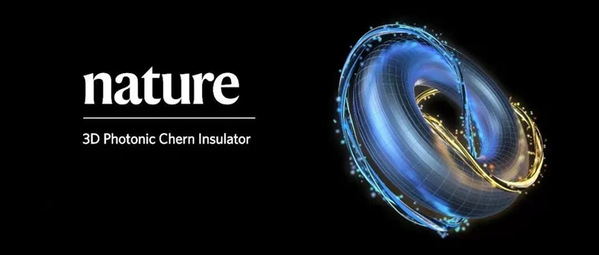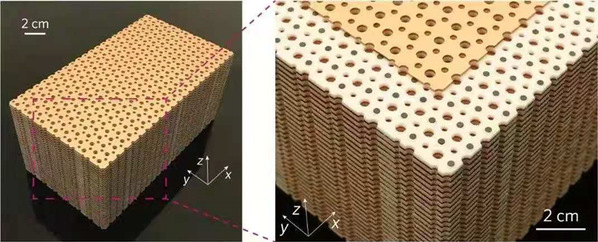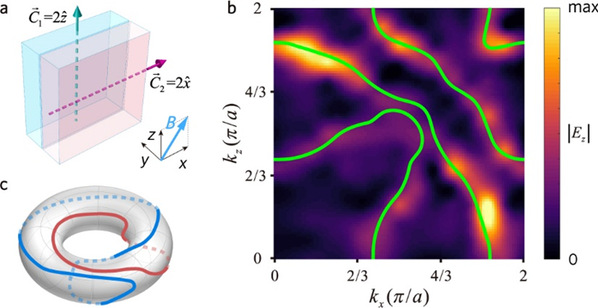Photonic 3D Chern insulator realized
Recently, Prof. YANG Yihao (one of the corresponding authors) from the International Campus of Zhejiang University and his collaborators at Nanyang Technological University announced their latest breakthrough: the world’s first realization of a long-elusive material called the 3D Chern insulator. These results are featured in the journal Nature, entitled “Topological Chern vectors in three-dimensional photonic crystals”, which open up new perspectives in the fundamental topological phases of matter.

Figure 1. Artistic view of the 3D Chern insulator
Photonic Chern insulators are immensely intriguing engineered photonic media with “insulating” bulk and “conducting” edge/surface. Owing to the genuine topological protection and backscattering immunity, the topological chiral edge modes of photonic Chern insulators are undeniably robust against disorders and imperfections, which can dramatically improve the transmission efficiency of photons. Compared to 2D counterparts, the 3D photonic Chern insulators support the 2D chiral surface states, representing one of the most reliable solutions for high-capacity information communications and highly miniaturized 3D photonic devices. However, the experimental validations of such photonic Chern insulators are limited to 2D, and the realization of 3D Chern insulators remained elusive prior to Prof. Yang’s work.
To overcome the above challenge, for the first time, Prof. Yang and his collaborators use magnetically tunable 3D photonic crystals to achieve the experimental demonstration of a 3D photonic Chern insulator and extend the Chern number from scalar to vector. Using a combination of bulk and surface measurements, they directly observe the 2D chiral surface states – the key feature of the 3D photonic Chern insulator, indicating its unique bulk-boundary correspondence. Additionally, they extend the famous Haldane model from 2D to 3D, and observe the topological phase transition from Weyl semimetals to 3D Chern insulators. These results could inspire the realization of 3D Chern insulators in other physical systems and may pave the way for 3D photonic topological devices, such as photonic cavities and lasers.

Figure 2. Experimental sample of the 3D photonic Chern insulator
Robust energy transport on the surfaces of the 3D photonic Chern insulator
In order to visualize the 2D chiral surface states of the 3D photonic Chern insulator, Prof. Yang and his collaborators place a point source on the surface of the experimental sample, and obtain the measured field distribution of chiral surface states via near-field measurements (see Figure 3a), which directly verifies the chiral transport of the surface states. Furthermore, they insert the copper pillars into the sample as metallic obstacles, as shown in Figure 3b. The corresponding measured field distribution indicates that the chiral surface states can propagate smoothly around the sharp corners and obstacles without scattering losses.

Figure 3. Robust 2D chiral surface states
Torus loops and links formed by the surface-states dispersions of the 3D photonic Chern insulator
Differing from the 2D photonic Chern insulator, which is characterized by a topological invariant consisting of a single integer - the scalar Chern number, the 3D photonic Chern insulator requires a Chern vector consisting of a vector of three Chern numbers. To investigate the property of the Chern vector, the researchers construct an interface between two 3D Chern insulators with the same amplitude but perpendicular Chern vectors (see Figure 4a). Then they measure the iso-frequency contours of the surface states, showing a (2, 2)-torus link formed by two interlinked torus knots (see Figures 4b and 4c). Further results show that other torus knots and torus links can be constructed by adjusting the Chern vector. This work, for the first time, establishes a connection between knot theory and topological photonics.

Figure 4. Hopf link surface states formed by perpendicular Chern vectors
More information: Prof. YANG Yihao from College of Information Science and Electronic Engineering and International Research Center for Information Science and Electronic Engineering, International campus, Zhejiang University, Prof. Baile Zhang and Prof. Yidong Chong from Nanyang technological university, and Prof. ZHOU Peiheng from the University of Electronic Science and Technology of China are the corresponding authors. Dr. Guigeng Liu from Nanyang technological university and Dr. GAO Zhen from Southern University of Science and Technology are the first authors. Dr. LIN Xiao from Zhejiang university and other researchers also contribute to this work.
Source: International Campus, Zhejiang University